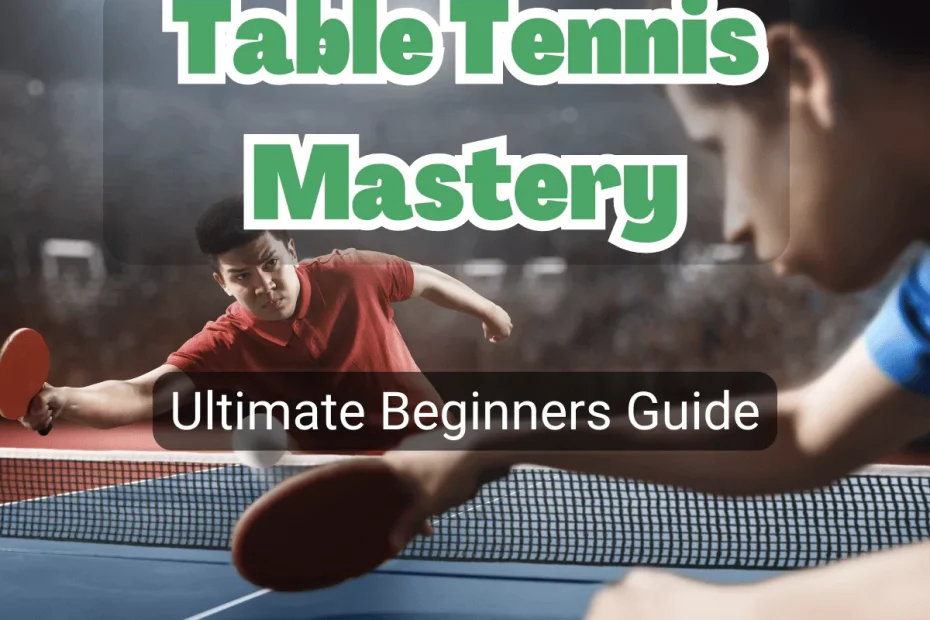Are you bored and looking for a fun and exciting way to pass the time? Have you ever considered playing table tennis?
Also known as ping pong, this high-speed paddle game is more than just a basement pastime – it’s a global sport with a rich history and a set of rules that make it both challenging and fun.
Whether you’re looking to conquer boredom or find a new hobby, this beginners guide will help you get started with table tennis and shed light on its rules and regulations.
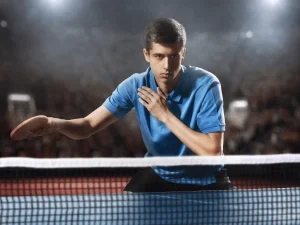
Article Content:
Ping Pong Benefits

Table tennis, AKA Ping Pong, is a fast-paced, exciting game that requires a blend of physical agility, strategic thinking, and sharp reflexes.
It’s a perfect boredom buster, offering endless hours of fun and challenge.
Here’s why:
- Fast-paced and engaging: There’s never a dull moment in a table tennis match. The ball moves at a rapid pace, keeping players on their toes and spectators at the edge of their seats.
- A brain workout: Table tennis isn’t just a physical game – it’s a mental one too. Players must think quickly and strategically, making it a great way to keep your mind sharp.
- Accessible and easy to learn: With just a table, a ball, and a pair of paddles, anyone can start playing. The basic rules are simple enough for beginners to grasp, yet the game can take years to master, adding a level of depth and longevity.
- Social and competitive: Table tennis is a social game that can be played with friends and family. Plus, with various leagues and competitions worldwide, those who wish to take their skills to the next level have plenty of opportunities.
- Affordable: Overall, buying and maintaining a table tennis table and the associated paddles and balls is a fairly inexpensive!
Related Articles:
- Rules of Pickleball {Complete 2023 Beginner Players Guide}
- How to Play Racquetball {The 2023 Ultimate Beginners Guide!}
- How to Play Tennis: A Comprehensive Beginners Guide (2023)
- How to Play Squash: A Complete Guide for Beginners (2023)
- What is Speedminton? The Ultimate Beginners Guide! (2023)
Getting Started
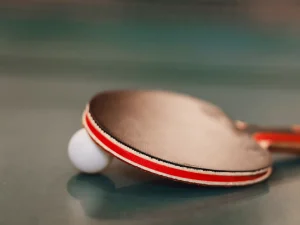
To get started with table tennis, you’ll need a table, a ball, and a paddle.
You’ll also need a basic understanding of the rules, which we’ll delve into in the upcoming sections of this guide.
Remember, the goal of the game is simple: hit the ball onto your opponent’s side of the table in a way that they can’t return it.
As you advance, you’ll learn more about service rules, doubles rules, and some odd table tennis rules that can add an extra layer of strategy to the game.
Ready to dive into the exciting world of table tennis?
Let’s go!
Know Your Equipment: An Essential Guide for Beginners
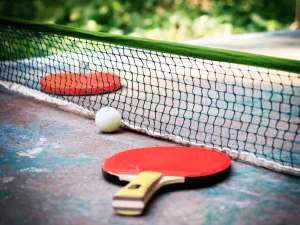
Understanding your equipment is just as important as understanding the rules of the game.
Choosing the Right Ping Pong Paddle
Choosing the right paddle is crucial to your gameplay.
Here are a few things to consider:
- Playing style: Defensive players might prefer a paddle with more control, while offensive players might want one with more speed.
- Grip style: Depending on whether you use a shakehand or penhold grip, you might prefer a paddle with a flared, straight, or penhold handle.
- Paddle speed, spin, and control ratings: These ratings indicate how the paddle performs in terms of speed, spin, and control. As a beginner, you might want to start with a paddle that offers good control.
Remember, the best paddle for you is one that fits your playing style and feels comfortable in your hand.

Required Paddle Specifications
In table tennis, paddle specifications are crucial.
Here are some key specifications:
- Blade: At least 85% of the blade must be natural wood. Other materials, such as carbon fiber or compressed paper, can be used to enhance speed or control, but they must be less than 7.5% of the total thickness or 0.35mm, whichever is smaller.
- Rubber: The rubber coating on each side of the paddle must be matt and of a bright red or black color. The rubber should not exceed 2mm in thickness.
These specifications are standardized by the ITTF to ensure fair play in competitive table tennis.
Remember, the best paddle for you is one that fits your playing style and feels comfortable in your hand.
Importance of Table Materials
The table’s material can influence the bounce and speed of the ball. Most regulation tables are made of high-quality wood, coated with a smooth, low-friction paint to facilitate a consistent bounce.
For casual play, tables can also be made of aluminum or other materials, but these may produce a different bounce.
Ping Pong Basic Rules
So, you’re ready to dive into table tennis, but where do you start? Let’s begin with understanding the basic rules of the game.
Basic Table Tennis Rules
Table tennis might seem daunting at first, but once you get the hang of the basic rules, you’ll be rallying in no time.
Here are some of the basic ping pong rules to know:
- The service: Each point begins with a service. The server must throw the ball vertically upwards without imparting spin, at least 16 cm (about 6.3 inches) high, and then hit it such that it first bounces on their side of the table and then the opponent’s side.
- Returning the ball: The player receiving the ball must let it bounce on their side of the table before returning it. The ball should then bounce on the opponent’s side of the table. If the ball doesn’t hit the table, the other player gets a point.
- Scoring: A player scores a point when their opponent fails to make a correct service, to make a correct return, or when the ball touches anything other than the net assembly before being struck by the opponent.
- Game and match: A game is won by the player first scoring 11 points unless both players have scored 10 points, then the game continues until one player leads by 2 points. A match is typically best of 5 or 7 games.
The more you play, the more familiar you’ll become with the rules and regulations.
How to Play a Ping Pong Match
In this step-by-step guide, we delve into the basic structure and rules of a ping pong match.
From setting up the game, understanding the rules of serving and returning, to scoring points and determining the winner, this guide offers a comprehensive walkthrough for beginners, or anyone interested in learning how a table tennis game unfolds.
Whether you’re new to the sport or simply need a refresher, this guide can help enhance your understanding and enjoyment of the game.
-
Setup

Both players stand on opposite sides of the table, with the Ping Pong net set up in the middle. Players decide who will serve first by a coin toss or some other fair means.
-
The Serve
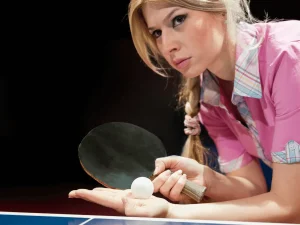
The player who serves first holds the ball flat in the palm of their hand and tosses the ball upwards. When the ball is falling down, the player hits the ball so that it first bounces on their own side of the table and then over the net to the opponent’s side.
-
The Return

The opposing player must then hit the ball back over the net after it has bounced once on their side of the table. The ball should not touch the net, nor should it bounce more than once on their side of the table.
-
The Rally
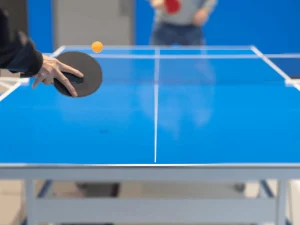
Play continues in this manner with players hitting the ball back and forth until one player fails to return the ball properly. This can occur if a player allows the ball to bounce more than once on their side, fails to hit the ball back onto the opponent’s side, hits the ball into the net, or hits the ball before it bounces on their side of the table.
-
Scoring

A point is scored by a player when their opponent fails to make a correct return. The player who scores the point will then serve next.
-
Rotation of Service

In table tennis, players alternate serves every two points. However, if the game reaches a score of 10-10, the serve changes every point until one player leads by 2 points.
-
Winning the Game
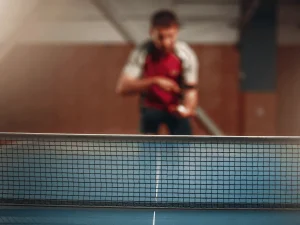
A standard game of table tennis is won by the player who first scores 11 points, with a minimum lead of 2 points. If the score becomes tied at 10-10, the game continues until one player gains a lead of 2 points.
-
Winning the Match
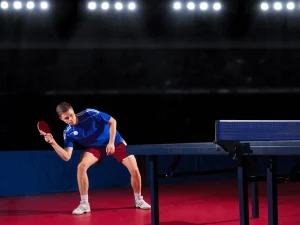
A match is typically composed of an odd number of games (often 5 or 7). The player who wins the majority of the designated games wins the match.
Remember, while these are the general rules, there can be slight variations depending on the specific rules of the competition or league in which you are playing.
Always be sure to understand the specific rules before you start a match.
Table Tennis Techniques
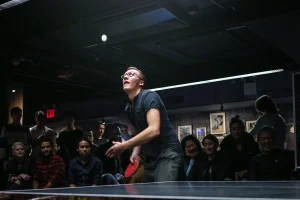
Grip Techniques for Beginners
Learning how to play table tennis involves mastering a series of techniques—from grip to serve to stroke to footwork.
But don’t worry, we’re here to guide you through each step!
The way you hold your paddle, or your ‘grip,’ is fundamental to your table tennis game. Here are two of the most common grip techniques:
- Shakehand Grip: Aptly named because you grip the paddle similarly to how you would shake hands, this grip is the most common in Western countries. The index finger rests on the back of the blade, with the thumb and remaining fingers wrapping around the handle.
- Penhold Grip: Common in Asian countries, this grip involves holding the paddle as you would a pen. The thumb and index finger grasp one side of the paddle, while the remaining fingers curl around the other side.
Experiment with both grips to see which feels most comfortable for you. Each has its advantages and can influence your serving and stroke techniques.
Serving Techniques

In table tennis, a good serve can give you a significant advantage.
Here are a couple of serving techniques to try:
- Backspin Serve: Strike the ball with a downward movement, aiming for the lower part of the ball. This will cause the ball to spin backwards, making it difficult for your opponent to return.
- Topspin Serve: Strike the ball with an upward movement, aiming for the top of the ball. This will cause the ball to spin forward, making it bounce higher and move faster.
Remember, in both singles and doubles, the serve must start from the right-hand “court” or box and land in the opponent’s right-hand court.
Stroke Techniques to Keep the Ball in Play
Here are a few basic stroke techniques:
- Forehand Drive: This is a basic attacking stroke, made with a straight arm from the elbow and a small wrist movement, hitting the ball with topspin.
- Backhand Drive: Similar to the forehand drive but made on the other side of the body. It’s a good defensive stroke, often used to counter topspin shots from your opponent.
- Push: A defensive stroke used to counter backspin shots. The aim is to lightly touch the ball, causing it to spin back to your opponent.
These techniques form the foundation of your table tennis game and mastering them will greatly enhance your gameplay. Remember, practice makes perfect!
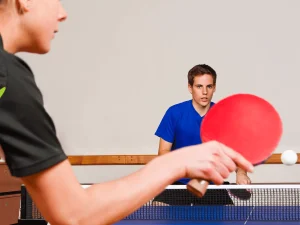
Footwork Techniques for Quick Movement
Proper footwork is crucial in table tennis. It allows you to move quickly and position yourself effectively for strokes.
Here are a few footwork patterns to practice:
- Sidestep: This is the most common footwork pattern. Move your feet sideways while keeping them parallel. It’s used for small adjustments during rallies.
- Cross-step: This involves crossing one foot behind or in front of the other. It’s useful for covering larger distances, especially in doubles play.
- Pivot: This involves rotating your body around one foot. It’s useful for executing powerful forehand strokes from the backhand side of the table.
Remember, good footwork begins with a balanced ready position.
Stand with your feet shoulder-width apart, knees slightly bent, and lean forward a bit from the waist.
Unraveling the Game: Understanding Match Play
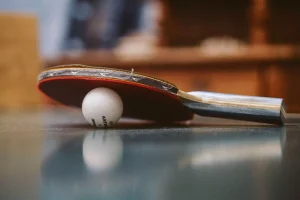
Understanding the rules and regulations of table tennis is fundamental to enjoying the game. Here are some essential rules that every player should know.
Service Rules in Table Tennis
In table tennis, the serve is crucial.
Here are the basic service rules:
- The server must throw the ball vertically upwards, at least 16cm (about 6 inches), and hit it as it falls without touching anything before it hits the server’s side of the table.
- The ball must first bounce on the server’s side and then the receiver’s side. In singles, the ball can bounce anywhere, but in doubles, it must bounce from the right half court of server to the right half court of the receiver.
- If the serve is legal and the receiver fails to make a good return, the server scores a point.
Doubles Rules in Table Tennis
Doubles table tennis involves a bit more coordination and strategy.
Here are the basic doubles rules:
- Teammates must alternate hitting the ball. For instance, if Player A serves, Player B must hit the next shot, then Player A, and so on.
- Each player serves for two points in a row, and then the serve switches to the opposing team.
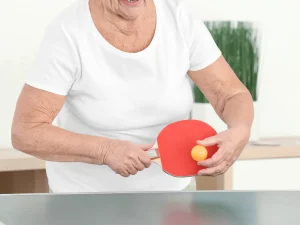
What Happens with an Accidental Double Hit in Table Tennis
Accidental double hits in table tennis can be tricky.
According to ITTF rules, if a player unintentionally hits the ball twice in succession, such as with both the paddle and a part of the body, the hit is considered legal and play should continue.
Odd Table Tennis Rules You Might Not Know
Table tennis has some peculiar rules that might surprise beginners:
- If the ball touches the net during service but still lands in the correct court, it’s considered a “let” and the server gets to serve again.
- If a player’s free hand touches the playing surface during a rally, they lose the point.
- In an official match, players can request a “time out” of up to one minute.
Advanced Techniques & Strategies
Whether you’re looking to take your table tennis game to the next level or just add some spice to your play, understanding advanced techniques and strategies can be a game-changer.
Introduction to Spin in Table Tennis
In table tennis, spin is a crucial element that can drastically affect the trajectory and bounce of the ball. There are three basic types of spin:
- Topspin: When the top of the ball is spinning forward as it travels, it creates topspin. This causes the ball to dip downwards and bounce forward on the opponent’s side.
- Backspin: Conversely, when the bottom of the ball is spinning forward, it creates backspin. Backspin causes the ball to bounce less on the opponent’s side, often catching them off-guard.
- Sidespin: When the ball is spinning either to the left or right, it creates sidespin. Sidespin can cause the ball to bounce in unpredictable directions, making it challenging for opponents to return.
Offensive vs. Defensive Strategies
Depending on your playing style, you might adopt either an offensive or defensive strategy in table tennis:
- Offensive Strategy: Offensive players aim to control the game and keep their opponents on the defensive. They often use aggressive shots like loops, smashes, and fast, deep serves to keep pressure on the opponent.
- Defensive Strategy: Defensive players aim to frustrate their opponents with a variety of returns, often incorporating heavy spin to disrupt the opponent’s rhythm. They rely on precise placement and changes in tempo to force errors from their opponents.
Importance of Placement & Variation in Play
Placing your shots effectively and varying your play are essential strategies in table tennis:
- Placement: The ability to place the ball accurately on the table can give you a significant advantage. Aim to exploit your opponent’s weak spots, often wide to the forehand or backhand, or into the crossover point (the transition area between forehand and backhand).
- Variation: Varying spin, speed, and direction of your shots can keep your opponent guessing and disrupt their timing. For instance, a well-placed slow shot after a series of fast ones can catch your opponent off guard.
Improve Your Table Tennis Skills:
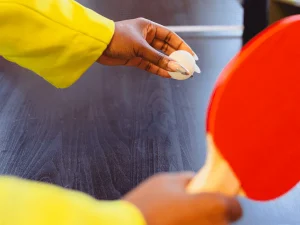
Practicing & Training
Solo Drills for Table Tennis Practice
When practicing table tennis alone, you can engage in several drills designed to improve your skills. Here are some you can try:
- Bounce the Ball on Your Paddle: This simple exercise can help beginners develop basic control over the ball. Try bouncing the ball on your paddle without letting it hit the floor. You can also alternate between backhand and forehand and vary the force you use to make the drill more challenging.
- Shadow Play: This is a training method where you emulate the motions you would use while playing. It’s a good way to get comfortable with the movements at your own pace and can be done anywhere.
- Service Practice: This drill can help you improve your control over serves. You don’t need a partner for this drill, just a collection of balls to practice your serves. Aim to vary spin, placement, and speed with each serve.
- Drills for Accuracy and Footwork: Cross Court, Down the Line, Backhand and Forehand, Backhand and 2X Forehand, Flick, Backhand & Forehand Loop Kill.
- Targeted Drills for Specific Shots: Loop Openers, Pushing, Looping, Chopping & Pushing, Smashing & Lobbing1.
How to Use a Table Tennis Robot for Practice
If you own a table tennis robot, you can dramatically enhance your solo table tennis practice sessions. These robots can provide varied feeds, allowing you to set up sequences of shots for practice.
For example, a short backspin ball, followed by a heavy topspin ball, and then a fast ball down the middle to finish. This variation makes your drills much more versatile2.
Unfortunately, I wasn’t able to find more specific information about how to use a table tennis robot for practice. There are many different types of table tennis robots on the market, and how you use one will depend on the specific features and capabilities of the model you have.
Generally, these robots can be set to deliver balls at different speeds, spins, and trajectories, providing a consistent and adjustable practice partner.
Benefits of Having a Coach or Mentor
A coach or mentor can offer personalized feedback, help refine your technique, and provide strategic advice based on their own experience. They can spot errors in your form or strategy that you may not notice, and they can guide your development in a way that aligns with your individual goals.
Looking to level up your table tennis game? Online resources can provide a wealth of knowledge and guidance.
Here are some online training courses that can help you improve your skills.
Online Training Courses & Resources

Table Tennis Online Training Courses for Beginners
Many online platforms offer training courses specifically designed for beginners.
These courses typically cover the basics of the game, including rules, techniques, and strategies.
Websites like Udemy, Coursera, and Skillshare feature a variety of table tennis courses taught by experienced coaches.
Table Tennis University Basics Mastery Course Review
Table Tennis University offers a comprehensive Basics Mastery Course.
This course is particularly beneficial for beginners as it offers in-depth lessons on fundamental techniques, tactics, and training drills.
The course also provides feedback and support from experienced coaches, which can be crucial in the early stages of learning.
Joining the Community
Joining a table tennis community can provide you with opportunities for practice, competition, and socialization.
Whether online or in-person, these communities can enhance your enjoyment of the sport and help you improve your skills.
Finding Local Table Tennis Clubs
Local table tennis clubs offer a great way to meet other enthusiasts and improve your game. These clubs often host regular practice sessions, clinics, and tournaments that can be excellent learning experiences.
To find a club near you, you can:
- Search online for table tennis clubs in your area
- Check with local community centers or sports facilities
- Ask fellow table tennis players for recommendations
Remember to choose a club that matches your skill level and fits your personal goals for the game.
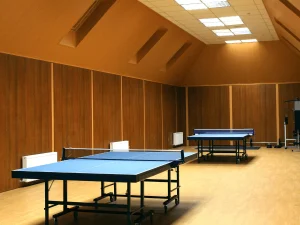
Table Tennis Tournaments & Competitions for Beginners
Participating in tournaments and competitions can be a fun and challenging way to test your skills. For beginners, there are often special divisions or events designed to provide a fair and enjoyable competition.
These events can also give you the opportunity to watch more experienced players and learn from their techniques.
Online Forums & Communities for Table Tennis Enthusiasts
Online communities are a valuable resource for learning more about table tennis and connecting with other players. Websites, forums, and social media groups can provide helpful tips, tutorials, equipment reviews, and opportunities to ask questions or discuss the game.
Always remember to be respectful and positive when participating in these communities.
Maintaining Your Equipment
Proper maintenance of your table tennis equipment can help ensure optimal performance and prolong the life of your gear.
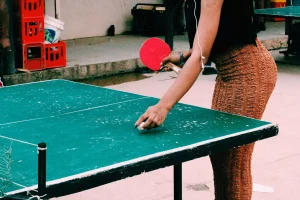
How to Clean & Maintain Your Table Tennis Paddle
Regular cleaning of your table tennis paddle is essential to maintain its performance. Here are some general steps you can follow:
- Use a specialized table tennis paddle cleaner or a mild soap solution
- Apply the cleaner lightly to the rubber surfaces using a sponge or cloth
- Gently wipe off the cleaner, moving from the handle to the tip of the paddle
- Let the paddle air-dry completely before storing or using it
Avoid using abrasive cleaners or scrubbing too hard, as this can damage the rubber surfaces of your paddle.
When to Replace Table Tennis Balls & paddle Rubber
Over time, table tennis balls and paddle rubber can wear out and lose their effectiveness. Here are some signs that it might be time to replace these items:
- Ping Pong Balls: If the ball has lost its roundness, has cracks, or doesn’t bounce as it should, it’s time for a replacement.
- Paddle Rubber: If the rubber is peeling, cracking, or has lost its stickiness, consider replacing it.
Remember, the frequency of replacement will depend on how often you play and the quality of your equipment.
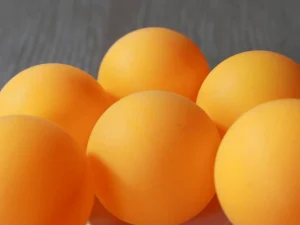
Exploring Professional Ping Pong
Once you’ve mastered the basics of table tennis, you might be interested in exploring the professional side of the sport.
This can provide inspiration, enhance your appreciation of the game, and give you goals to strive for.
Famous Table Tennis Players to Watch
Watching professional players can be a great way to learn advanced techniques and strategies. Some famous table tennis players to watch include:
- Ma Long: Often considered one of the greatest players of all time, Ma Long of China has an aggressive playing style that utilizes powerful loops and quick footwork.
- Fan Zhendong: Another top player from China, Fan Zhendong is known for his exceptional speed and agility.
- Ding Ning: One of the top female players in the world, Ding Ning’s playing style is characterized by her strong serves and unpredictable spins.
- Timo Boll: This German player is admired for his quick reflexes and strategic play.
- Tomokazu Harimoto: A young prodigy from Japan, Harimoto has been making waves on the international scene with his tenacious style.
Major Table Tennis Tournaments Around the World
If you’re interested in watching professional table tennis, there are several major tournaments around the world you should be aware of:
- World Table Tennis Championships: This prestigious event, hosted by the ITTF, brings together the top players from around the world.
- Olympic Games: Table tennis has been an Olympic sport since 1988, and it’s one of the highlights of the summer games.
- ITTF World Tour: This series of international tournaments takes place throughout the year, offering plenty of opportunities to watch high-level play.
- National Championships: Many countries, including the United States, China, and Germany, host their own national championships.
The Role of the International Table Tennis Federation (ITTF)
The International Table Tennis Federation (ITTF) is the governing body for the sport of table tennis. Founded in 1926, the ITTF oversees international competitions, sets the rules for the game, and works to promote the sport worldwide.
The ITTF also maintains the world rankings for players and sanctions professional tournaments.
For anyone interested in professional table tennis, the ITTF’s website is a valuable resource for news, tournament information, and player profiles.
Frequently Asked Questions (FAQ)

What’s the difference between ping pong and table tennis?
There is no difference between ping pong and table tennis. The terms are used interchangeably, although “table tennis” is the official term used by the International Table Tennis Federation (ITTF) and at professional levels of play.
What are some unusual rules in table tennis that beginners might not know?
One unusual rule in table tennis is that you must serve diagonally from right half court to the opponent’s right half court in singles play. Another interesting rule is that if the ball hits the edge of the table, it is considered in play.
When was table tennis first played
The game of table tennis was first played in the late 1880s when it was used as an after-dinner amusement for upper-class Victorians in England.
Conclusion
Table tennis, with its rich history, thrilling gameplay, and extensive community, offers a world of opportunity for players of all skill levels.
Whether you’re a beginner picking up your first paddle or an advanced player striving for mastery, there’s always something new to learn and explore in this dynamic sport.
From understanding the basics of the game and equipment, learning and practicing new techniques, to joining a community of enthusiasts and even exploring the professional scene, table tennis truly has something for everyone.
Remember, the journey to mastering table tennis is a marathon, not a sprint, so take your time, enjoy each step, and keep the ball bouncing!

Hey Everyone!
Chritt here. I just want to say THANK YOU SO MUCH for visiting Boredom Busted. It’s been my passion project going on 7 years now.
I need a favor though. If you have found the page you landed on or explored useful in any ways – please please please share, or comment.
The more engagement on this page – the more I can continue to write and provide helpful content to my visitors like you.
I love you all and thank you again for visiting! Don’t be a stranger and hope to see you back, soon!

